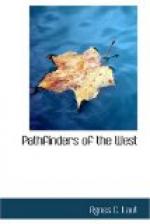Relief came with the breaking of the weather. The rain washed the iced snows away; deer began to roam; and with the opening of the rivers came two messengers from the Sioux to invite Radisson and Groseillers to visit their nation. The two Sioux had a dog, which they refused to sell for all Radisson’s gifts. The Crees dared not offend the Sioux ambassadors by stealing the worthless cur on which such hungry eyes were cast, but at night Radisson slipped up to the Sioux tepee. The dog came prowling out. Radisson stabbed it so suddenly that it dropped without a sound. Hurrying back, he boiled and fed the meat to the famishing Crees. When the Sioux returned to their own country, they sent a score of slaves with food for the starving encampment. No doubt Radisson had plied the first messengers with gifts; for the slaves brought word that thirty picked runners from the Sioux were coming to escort the white men to the prairie. To receive their benefactors, and also, perhaps, to show that they were not defenceless, the Crees at once constructed a fort; for Cree and Sioux had been enemies from time immemorial. In two days came the runners, clad only in short garments, and carrying bow and quiver. The Crees led the young braves to the fort. Kettles were set out. Fagged from the long run, the Sioux ate without a word. At the end of the meal one rose. Shooting an arrow into the air as a sign that he called Deity to witness the truth of his words, he proclaimed in a loud voice that the elders of the Sioux nation would arrive next day at the fort to make a treaty with the French.
The news was no proof of generosity. The Sioux were the great warriors of the West. They knew very well that whoever formed an alliance with the French would obtain firearms; and firearms meant victory against all other tribes. The news set the Crees by the ears. Warriors hastened from the forests to defend the fort. The next day came the elders of the Sioux in pomp. They were preceded by the young braves bearing bows and arrows and buffalo-skin shields on which were drawn figures portraying victories. Their hair was turned up in a stiff crest surmounted




